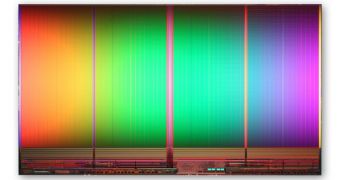Back in 2006, after seeing how quickly Flash memory was growing in popularity, Intel and Micron decided to pool their resources and create a joint venture meant to conduct research and development of NAND Flash chips. This allowed both partners to become quite prominent on the SSD front, to the point where Intel decided to invest a significant amount of attention into this endeavor. Efforts culminated around the end of January, when the two companies proudly announced that they had completed the development of 25nm NAND chips.
SSDs based on this 25nm process technology bring both the benefit of a higher maximum capacity and of higher affordability. To be precise, compared with 34nm chips, which spawned the flagship 4GB 2-bit-per-cell MLC NAND device, the 25nm technology enables twice as large a capacity (8GB/54Gb) on a die size of just 167mm2. It is this product that IMFT (Intel-Micron Flash Technologies) has now started mass-producing.
“Through our continued investment in IMFT, we’re delivering leadership technology and manufacturing that enable the most cost-effective and reliable NAND memory,” Tom Rampone, vice president and general manager, Intel NAND Solutions Group, stated back when the 25nm process was first presented. “This will help speed the adoption of solid-state drive solutions for computing.”
“To lead the entire semiconductor industry with the most advanced process technology is a phenomenal feat for Intel and Micron, and we look forward to further pushing the scaling limits,” Brian Shirley, vice president of Micron’s memory group, explained around the same time. “This production technology will enable significant benefits to our customers through higher density media solutions.”
IMTF's fabs are already shipping the 8GB MLC chip, which will be used in future SSDs, portable music players, digital camcorders, cameras and smartphones, among other things. The first Intel solid state drives to take advantage of 25nm NAND should show up in the second half of the year.

 14 DAY TRIAL //
14 DAY TRIAL //